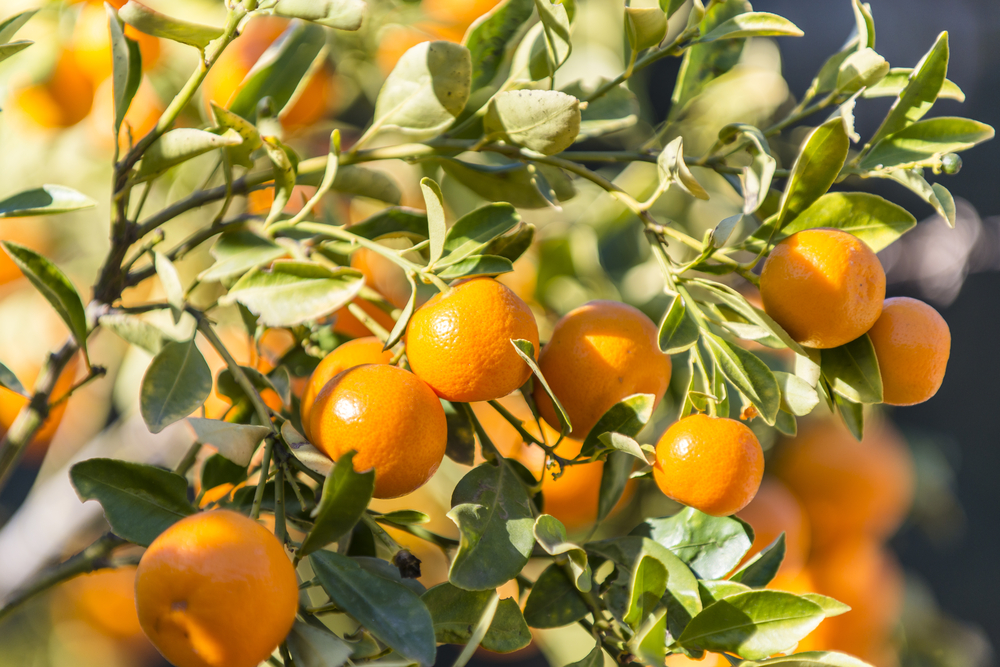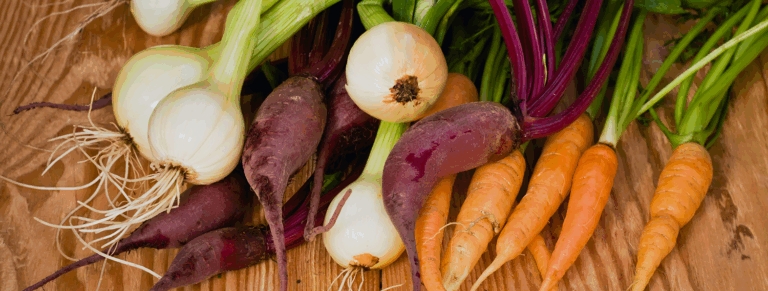Scientific name:Citrus reticulata Common name:Tangerine or Mandarin Orange, Red Tangerine, Chen Pi (Aged Citrus peel)
Constituents:1-3
- Volatile oils including ~60-95% limonene, terpinene, β-myrcene, linalool, β-citronellal, α-pinene, β-pinene, α-sinensal, β-copaene, geranial, geraniol, neral & nerol, b-caryophyllene and others.
- Flavonoids including Polymethoxylated flavones (e.g. tangeretin, nobiletin and others) and citrus flavanones (hesperidin & naringin and others)
- Fatty aldehydes (octanal, decanal, dodecanal, and others)
- Alkaloids (synephrine, N-methyl tyramine, and stachydrine)
- Coumarins
- Phytosterols (β-sitosterol)
- Vitamins & Minerals
Medicinal Actions:4-7
- Anti-bacterial
- Anti-emetic
- Anti-fungal
- Anti-inflammatory
- Antioxidant
- Carminative (Stomachic)
- Expectorant
- Thermogenic agent
Traditional Use:4,5
- Dried peel (Chen Pi) has a long traditional use in Chinese Medicine (TCM) as a warming bitter which enters the spleen, lung, and stomach meridians to regulate Qi and resolve stagnation. It’s described as having the ability to strengthen the spleen, dry dampness, and to resolve phlegm. In TCM is frequently combined with other herbs to synergistically enhance a formulations overall effects.
- In accordance with TCM principles, it is often used as a stomachic to assist with digestion and food stagnation involving symptoms such as gas, bloating, abdominal distension, nausea, vomiting, and upset stomach, particularly when caused by liver-stomach disharmony. Is also widely used to alleviate respiratory inflammation and cough with expectoration of phlegm.
Evidence Based Use:
- Many preclinical trials indicate a wide range of pharmacological actions pertaining to antioxidant and anti-inflammatory effects within the gastrointestinal and respiratory systems, and protective effects upon the liver, nerves, and circulatory system.4,8
- Experimental studies have demonstrated bi-directional effects on gastrointestinal motility, both promoting and inhibiting intestinal smooth muscle contraction.9
- Studies have shown that citrus flavanones and their metabolites are able to influence the microbiota composition and activity and exert beneficial effects on intestinal barrier function and gastrointestinal inflammation.10
- Consumption of citrus flavanones has been repeatedly associated with a lower risk of cardiovascular and degenerative diseases related to antioxidant and anti-inflammatory activities.10-12 Pharmacological studies have also shown a potential for regulating blood lipids and having anti-thrombotic and anti-atherosclerotic effects.13
- Demonstrates broad spectrum anti-bacterial and anti-fungal activity and has been shown to inhibit the growth of Escherichia coli, Pseudomonas aeruginosa, Staphylococcus aureus and Aspergillus niger and other pathogenic organisms in vitro.14
Mechanism of Action + Pharmacology:
- Anti-inflammatory and anti-oxidant effects have been ascribed to the potent collective effect of flavonoids (e.g. hesperidin, nobiletin, naringenin, and tangeretin) which have been shown to reduce the secretion of pro-inflammatory cytokines in vitro (e.g. prostaglandin E2, nitric oxide, TNF-α, IL-1β, and IL-6), adjust the function of the cardiovascular system, protect the nervous system, and improve the bioavailability of other substances when used in combination.15,16
- Citrus flavanones (e.g. hesperidin & naringin) are considered to be largely resistant to enzymatic breakdown in the stomach and small intestine and mainly reach the colon intact, where they appear to modulate microbiota composition and activity.8
- Volatile oils and flavonoids appear responsible for antimicrobial effects, potentially resulting from permeability changes to the cytomembrane and the fragility of cell walls caused by chitin inhibition.2,10
- Alkaloid synephrine is a sympathomimetic agent which can improve metabolism, have thermogenic effects, and may promote gastrointestinal movement by increasing the levels of acetylcholine and motilin and decreasing the levels of substance P and vasoactive intestinal peptide.17
Safety + Toxicity Concerns:18
- No known contraindications.
- No information on safety in pregnancy or lactation available. Safety has not been conclusively established.
Interactions:
- None known.
References:
- González-Mas, M. C., et al. (2019). Volatile compounds in citrus essential oils: A comprehensive review. Frontiers in Plant Science, 10, 12.
- Wu, T., et al. (2014). Antifungal action and inhibitory mechanism of polymethoxylated flavones from Citrus reticulata Blanco peel against Aspergillus niger. Food Control, 35(1), 354-359.
- Fu, M., et al. (2019). Anti-asthmatic activity of alkaloid compounds from Pericarpium Citri Reticulatae (Citrus reticulata ‘Chachi’). Food & function, 10(2), 903-911.
- Yu, X., et al. (2018). Citri Reticulatae Pericarpium (Chenpi): Botany, ethnopharmacology, phytochemistry, and pharmacology of a frequently used traditional Chinese medicine. Journal of Ethnopharmacology, 220, 265-282.
- Valussi, M. (2012). Functional foods with digestion-enhancing properties. International journal of food sciences and nutrition, 63(sup1), 82-89.
- Wang, Y., et al. (2017). Antioxidant capacity, anticancer ability and flavonoids composition of 35 citrus (Citrus reticulata Blanco) varieties. Molecules, 22(7), 1114.
- Viuda‐Martos, M., et al. (2008). Antibacterial activity of lemon (Citrus lemon L.), mandarin (Citrus reticulata L.), grapefruit (Citrus paradisi L.) and orange (Citrus sinensis L.) essential oils. Journal of food safety, 28(4), 567-576.
- Huang, Y. S., & Ho, S. C. (2010). Polymethoxy flavones are responsible for the anti-inflammatory activity of citrus fruit peel. Food Chemistry, 119(3), 868-873.
- Liang, P. L., Chen, X. L., Gong, M. J., Xu, Y., Tu, H. S., Zhang, L., … & Xu, E. Guang Chen Pi (the Peel of Citrus Reticulata ‘Chachi’) Prevents Atherosclerosis by Anti-Inflammatory and Inhibiting Foam Cell Formation.
- Stevens, Y., et al.. (2019). The intestinal fate of citrus flavanones and their effects on gastrointestinal health. Nutrients, 11(7), 1464.
- Cassidy, A., et al. (2012). Dietary flavonoids and risk of stroke in women. Stroke, 43(4), 946-951.
- Knekt, P., et al. (2002). Flavonoid intake and risk of chronic diseases. The American journal of clinical nutrition, 76(3), 560-568.
- Goetz, M. E., et al. (2016). Flavanone intake is inversely associated with risk of incident ischemic stroke in the REasons for Geographic and Racial Differences in Stroke (REGARDS) Study. The Journal of nutrition, 146(11), 2233-2243.
- YU, J. J. (2016). Research progress in anti-cardiovascular and cerebrovascular disease activity of Citri Reticulatae Pericarpium. Chinese Traditional and Herbal Drugs, 3127-3132.
- Dosoky, N. S., & Setzer, W. N. (2018). Biological activities and safety of Citrus spp. essential oils. International journal of molecular sciences, 19(7), 1966.
- Liu, X. R., et al. (2011). Advances in studies on the biological activities of hesperidin and hesperetin. Chin. J. New Drugs, 20(4), 329-381.
- Chutia, M.,et al. (2009). Antifungal activity and chemical composition of Citrus reticulata Blanco essential oil against phytopathogens from North East India. LWT-Food Science and Technology, 42(3), 777-780.
- Gardner, Z., & McGuffin, M. (Eds.). (2013). American Herbal Products Association’s botanical safety handbook. CRC press.







